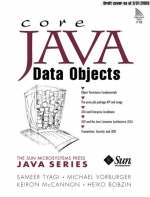
Core Java Data Objects
Prentice Hall (Verlag)
978-0-13-140731-2 (ISBN)
- Titel ist leider vergriffen;
keine Neuauflage - Artikel merken
The need for persistence is a prerequisite for any enterprise application and the case is no different for applications written in the Java programming language. A typical Java application will consist of code that is responsible for storing and retrieving the application specific data to some kind of storage facility so that it can be retrieved and used at a later time. Now there is a new alternative-Java Data Objects (JDO) that is well placed to change the way developers have traditionally perceived persistence in their applications. JDO is a standard developed under the auspices of the Java Community Process by a number of industry participants. JDO is a new technology, but it is one that holds great promise. If you are an architect, a developer or even a manager that is involved with persistence in Java and would like to gain an insight into this technology then this book is for you.
SAMEER TYAGI is Enterprise Java Architect at Sun Microsystems' Java Center in Burlington, MA. He co-authored Professional JSP, Professional JSP-J2EE Edition, and Professional Java Server Programming-J2EE Edition, and writes regularly for Java Pro, JavaWorld, and Java Developers Journal. MICHAEL VORBURGER is Chief Software Architect for Vertical*I, a firm providing enterprise software solutions to the life sciences industries. He has implemented large-scale persistence systems inspired by the JDO standard. KEIRON MCCAMMON, CTO, Versant Corporation, responsible for product strategy and direction, has worked with finance and telecom customers to develop and deploy large scale Java/J2EE distributed object solutions. A member of the JDO expert group, he presents regularly on JDO at leading events. HEIKO BOBZIN, also a member of the JDO expert group, led JDO and ODMG 3.0 implementation at Poet Software.
Foreword.
Preface.
Acknowledgments.
I. INTRODUCTION.
1. JDO Overview.
JDO Background. Domain Object Model. Orthogonal Persistence. Non-Managed and Managed Environments. Roles and Responsibilities. Summary.
2. Object Persistence Fundamentals.
Persistence in Applications. JDK Binary Serialization. Object-Relational Mapping. Rolling Your Own Persistence Mapping Layer. Conclusion.
II. THE DETAILS.
3. Getting Started with JDO.
How Does JDO Work? The JDO Basics. Defining a Class. Connecting to a Datastore. Creating an Object. Reading an Object. Updating an Object. Deleting an Object. JDO Object Model. Exception Handling. Object Identity. Types of Object Identity. Object Lifecycles. Concurrency Control. Summary.
4. Object Lifecycle.
A Persistent Object's Lifecycle. Finding Out about an Object's State. Operations That Change State. Callbacks. Optional States. Putting It All Together. Summary.
5. Developing with JDO.
JDO Concepts. JDO Interfaces and Classes. Basic APIs. Exception Classes. Additional APIs. Service Provider Interface APIs. Summary.
6. Finding Your Data.
Finding an Object by Identity. Finding a Set of Objects Using an Extent. Finding Objects with the Query Facility. JDOQL. Queries, Filters, and Optional parameters. More on the Query Interface. Summary.
7. Architecture Scenarios.
JDO versus JDBC. RDBMS, ODBMS, and Flatfiles. J2EE, RMI, and CORBA. Managed and Non-Managed Environments. Multi-Threaded Applications. Summary.
III. J2EE.
8. JDO and the J2EE Connector Architecture.
J2EE Connector Architecture Overview. JDO and the J2EE Connector Architecture. Using JDO and the J2EE Connector Architecture. Using JDO without the J2EE Connector Architecture. Summary.
9. JDO and Enterprise JavaBeans.
Introduction. Session Beans and JDO. Message-Driven Beans and JDO. Entity Beans and JDO. To Use EJB or Not to Use EJB? Summary.
10. Security.
Security Levels. Implementing PersistenceCapable. Application Security. Summary.
11. Transactions.
Transaction Concepts. Transactions in Java. Transactions in JDO. Summary.
IV. THE CONCLUSION.
12. JDO and JDBC.
JDBC 2.0 and 3.0. Example: Storing Objects in a Relational Database Using JDBC. Comparison of JDBC and JDO. Summary.
13. Tips, Tricks and Best Practices.
Data Modeling. JDO and Servlets. Keep Domain Classes Separate from Others. Using XML as a Data Exchange Format. Validation. Summary.
14. The Road Ahead.
Advanced Transaction Semantics. Performance Optimizations. Managed Relationships. Query Enhancements. Object Mapping. Enumeration Pattern. Summary.
15. Case Study: The Core JDO Library.
Files, Packages and Object Model. Persistent Model Package. Use-case Package. BookOperation Class. Putting Things Together.
Appendix A: JDO States.
Appendix B: XML Metadata.
Appendix C: JDOQL BNF Notation.
Appendix D: PersistenceManager Factory Quick Reference.
Appendix E: JDO Implementations.
Index.
| Erscheint lt. Verlag | 25.9.2003 |
|---|---|
| Verlagsort | Upper Saddle River |
| Sprache | englisch |
| Maße | 178 x 234 mm |
| Gewicht | 737 g |
| Themenwelt | Informatik ► Programmiersprachen / -werkzeuge ► Java |
| Mathematik / Informatik ► Informatik ► Web / Internet | |
| ISBN-10 | 0-13-140731-7 / 0131407317 |
| ISBN-13 | 978-0-13-140731-2 / 9780131407312 |
| Zustand | Neuware |
| Haben Sie eine Frage zum Produkt? |
aus dem Bereich


